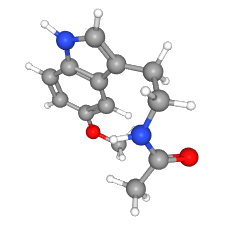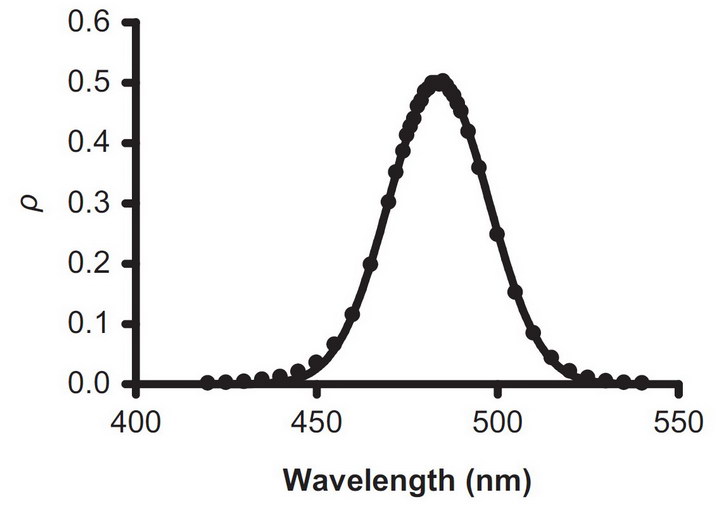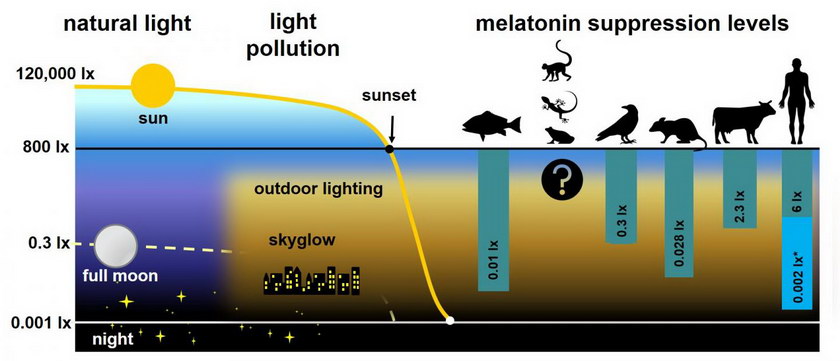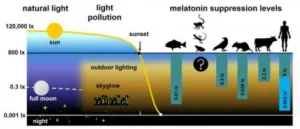Recently I did a Display Daily on the Eyesafe blue light logo program from TÜV Rheinland and Eyesafe. The goal of this program was to reduce the possibility of physical damage to the retina by blue light.

 The melatonin molecule (C13H16N2O2). (Credit: National Center for Biotechnology Information)
The melatonin molecule (C13H16N2O2). (Credit: National Center for Biotechnology Information)
The most recent issue of Information Display included an editorial and two articles on blue light, white light and displays. The first is by John Bullough (Rensselaer Polytechnic) and Stefan Peana (Dell) and deals mostly with damage to the eye from blue light, similar to my last DD. Unlike TÜV Rheinland and Eyesafe, they gave a limit understandable to display engineers. They said,
“A rule of thumb for broadband sources of light is that if the source’s luminance does not exceed 10,000 cd/m² [nits], we can assume the acute risk of blue-light hazard is negligible.”
So if you have a 10,000 nit HDR display, don’t stare at it for hours on end while it displays maximum brightness. More common displays in the 200 – 1000 nit range aren’t a hazard, even with long term use. Of course, light sources used in displays like LEDs and arc lamps can far exceed 10,000 nits and should not be stared at.
Blue light, and light in general, has another, more subtle effect on humans: it can suppress melatonin production and affect the circadian rhythm. This, in turn, can affect alertness, good in the daytime, and drowsiness, good when you want to go to bed at night. In this Display Daily, I will examine the science behind this disruption. In tomorrow’s DD, Melatonin, Circadian Rhythm and Displays, Part 2: The Products, I will examine products introduced by display companies said to have less effect on melatonin and circadian rhythm than normal display products.
 Melanopic sensitivity of the eye. (Credit: al Enezi, et. al.; Journal of Biological Rhythms)
Melanopic sensitivity of the eye. (Credit: al Enezi, et. al.; Journal of Biological Rhythms)
Melatonin is a natural hormone that occurs in the human body. This hormone helps regulate the daily sleep and awake cycle of the body, known as the circadian rhythm. When the body has higher levels of melatonin, the individual tends to be sleepy and less alert. When the body has low levels of melatonin, the individual tends to be awake and more alert. This is not an absolute relationship – you can fall asleep with low levels of melatonin, although it might take longer, and you can be awake and alert with higher levels of melatonin. When blue light falls on one type of retinal cells known as intrinsically photosensitive retinal ganglion cells (ipRGCs), the blue light suppresses the body’s production of melatonin. In the morning, this would be desirable and some people use bright, full spectrum lamps to read the morning newspaper and reduce the melatonin in the body.
The sensitivity to light in the production of melatonin actually extends well beyond the blue range of light and well into the green, almost to 550nm, as shown by the image above. This curve comes from a paper published by Jazi al Enezi et. al. in the August 2011 issue of the Journal of Biological Rhythms. Al Enezi is from the University of Manchester and one of his co-authors was from Philips Lighting. In this figure, the solid dots are al Enezi’s data points (derived from a study of mice) while the solid curve is a fitted gaussian with a peak at 484nm.
 The relation between light (illuminance levels) and melatonin suppression in humans and vertebrates. (Credit: Andreas Jechow, Icons made by Freepik)
The relation between light (illuminance levels) and melatonin suppression in humans and vertebrates. (Credit: Andreas Jechow, Icons made by Freepik)
If one wanted to avoid suppressing melatonin production in the body, it would be necessary not only to reduce blue light but reduce green light as well. Perhaps if you were willing to look at an old plasma display that showed only orange, you wouldn’t need to worry, but if you want a full-color display, it should be dim. This dimness extends not just to your computer screen but to your cellphone, TV and ambient lighting. Perhaps installing low color temperature “warm” light bulbs, e.g. incandescent lamps or LEDs with a CCT of 2700K or 3000K, in areas you use in the evening would help.
Since it takes several hours for melatonin to build up in your system after suppression by blue and green light ends, this would be for the entire evening, not just the last few minutes before bedtime. Even very low levels of ambient light begin to suppress melatonin production: 6 lux of broad-spectrum light or only 0.002 lux of blue light. These light levels are too low to read or do other common tasks, so, in the modern world, one can expect at least some suppression of melatonin at bedtime.
Melatonin is not just made in the body – it is available over-the-counter without a prescription in the US. According to WebMD,
“Melatonin [supplement] is most commonly used for insomnia and improving sleep in different conditions. For example, it is used for jet lag, for adjusting sleep-wake cycles in people whose daily work schedule changes (shift-work disorder), and for helping people establish a day and night cycle.”
WebMD adds that melatonin supplements are sometimes used by blind people where the eyes do not stimulate or suppress melatonin production. Most of the uses of over-the-counter melatonin supplements have not been proved to be effective by medical testing and there is only anecdotal evidence of the effectiveness. On the other hand, melatonin in reasonable dosages (0.25 – 5mg daily or up to 12mg a day for limited time periods) seems to have few side effects. If you have more than the normal amount of trouble falling asleep or with jet jag, you might try it and see if it works for you.
In tomorrow’s DD, Melatonin, Circadian Rhythm and Displays, Part 2: The Products, I will talk about display products that have been introduced to control the amount of blue light a person sees. –Matthew Brennesholtz

